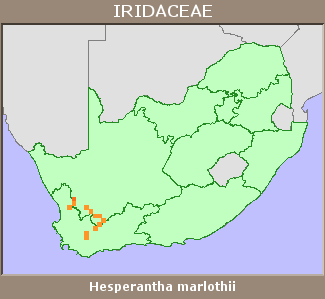|
Scientific Name | Hesperantha marlothii R.C.Foster |
Higher Classification | Monocotyledons |
Family | IRIDACEAE |
National Status |
Status and Criteria | Least Concern |
Assessment Date | 2021/06/09 |
Assessor(s) | W. Foden, L. Potter & T. Patel |
Justification | This species has an extent of occurrence (EOO) of 30 013 km², and an area of occupancy (AOO) of 112 km². It is not under threat and is therefore listed as Least Concern. |
Distribution |
Endemism | South African endemic |
Provincial distribution | Northern Cape, Western Cape |
Range | This species is endemic to South Africa, and is relatively widespread, extending along the Roggeveld Escarpment near Sutherland in Northern Cape, and in the Cold Bokkeveld and mountains east of Hex River Pass in Western Cape. |
Habitat and Ecology |
Major system | Terrestrial |
Major habitats | Fynbos |
Description | It usually occurs on rocky, sandstone pavement in shallow, seasonally wet, sandy ground. |
Threats |
| This species has no known threats. |
Population |
It is known from between 10 and 15 subpopulations and is under no apparent threat, the population is therefore stable.
|
Population trend | Stable |
Assessment History |
Taxon assessed |
Status and Criteria |
Citation/Red List version | | Hesperantha marlothii R.C.Foster | Least Concern | Raimondo et al. (2009) | |
Bibliography |
Goldblatt, P. and Manning, J.C. 2000. Cape Plants: A conspectus of the Cape Flora of South Africa. Strelitzia 9. National Botanical Institute, Cape Town.
Goldblatt, P. and Manning, J.C. 2020. Iridaceae of southern Africa. Strelitzia 42. South African National Biodiversity Institute, Pretoria.
Raimondo, D., von Staden, L., Foden, W., Victor, J.E., Helme, N.A., Turner, R.C., Kamundi, D.A. and Manyama, P.A. 2009. Red List of South African Plants. Strelitzia 25. South African National Biodiversity Institute, Pretoria.
|
Citation |
| Foden, W., Potter, L. & Patel, T. 2021. Hesperantha marlothii R.C.Foster. National Assessment: Red List of South African Plants version 2024.1. Accessed on 2025/10/26 |
 Comment on this assessment
Comment on this assessment


